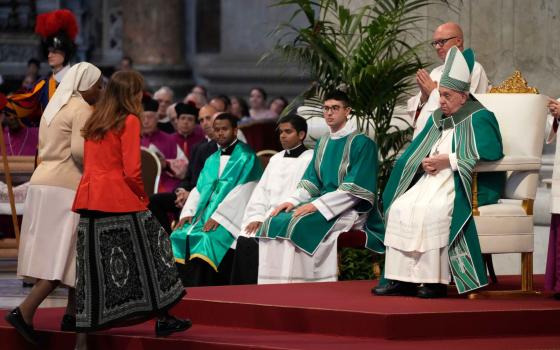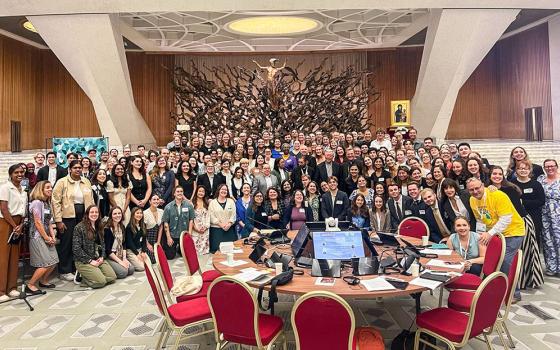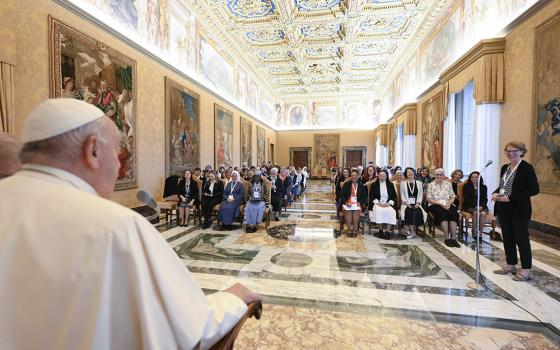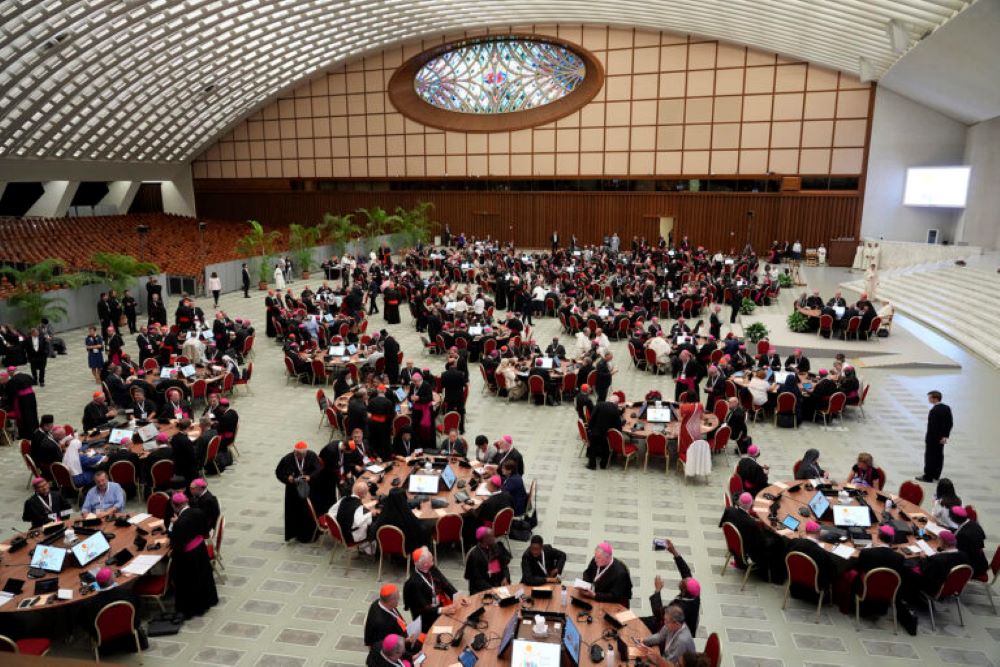
Pope Francis, sitting at far right table, participates in the opening session of the 16th General Assembly of the Synod of Bishops in the Paul VI Hall at the Vatican Oct. 4, 2023. The 2024 assembly is set for Oct. 2-27. (RNS/AP/Gregorio Borgia)
The second session of the Synod on Synodality will take place this October as a follow-up to the first session that occurred last October. Here are five things to look for as the synod delegates gather in Rome.
First, how is the second session similar to the first session of the synod?
The first session of the synod took place last October after a worldwide consultation process that asked people how they thought the church should respond to the challenges that faced it and the world.
The consultation began at the parish and diocesan level and was further discussed and synthesized at the national and continental levels. All of this was passed on to the synod office in Rome, which synthesized the suggestions and shared them with the synod participants.
This first session was like no other synod before it. There were fewer long speeches, and discussion took place at roundtables of 10, with delegates following a methodology of "conversations in the Spirit." Earlier synods had had only bishops and a few priests, while at the Synod on Synodality about a quarter of the participants were lay people, including women. The second session will include the same delegates as last year except for a few substitutes who will replace those unable to return.
Rather than simply debating issues at the tables, the stress at last year’s synod was on listening to each other. First, each participant would share his or her thoughts and feelings about an issue without interruption. Then they would go around the table again with each person sharing what they heard.
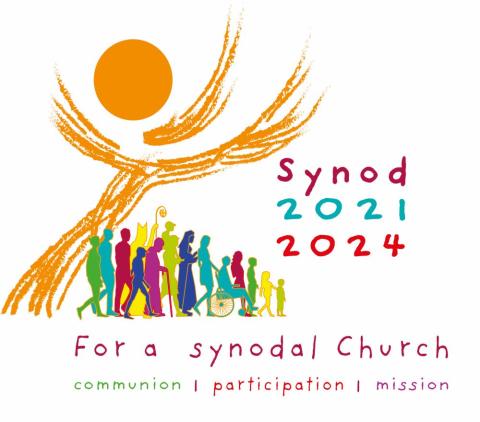
(Vatican Media)
Only after listening and sharing what they had heard was there a free discussion. In the process, everyone was treated equally whether they were a lay person or cardinal. Moderators were present at each table to guide the process and to make sure bishops did not dominate the discussion.
Each table drew up a report on its conclusions, which were shared with the rest of the synod. The full synod ultimately voted on a final report, each paragraph of which required a two-thirds vote.
All of this was done behind closed doors with the members of the synod instructed not to share with the press or the public what went on in the synod. Only the final report was public.
This year’s session will follow the same methodology of conversations in the Spirit as the first session.
Second, how will the second session differ from the first session?
The agenda for the first session came from the worldwide consultations. As a result, lots of issues were discussed including controversial ones like women deacons and the church’s approach to LGBTQ+ persons.
Many of the controversial issues could not be resolved because of disagreements among the delegates. For example, although the term LGBTQ+ is now commonly used by the Vatican, it was left out of the final report because the drafters feared that any paragraph including this term would not get a two-thirds vote due to opposition from African and Eastern European bishops.
In the final report, the synod called for further study of the issues they could not resolve. The assumption was that the results of these studies would provide input for the second session of the synod.
Pope Francis, however, decided these issues need more study than could be completed in a year. In addition, he thinks the complexity of these topics would distract from the main theme of the synod. He wants the synod to focus on "How to be a synodal church on mission?"

Dozens of women march to the Vatican, Oct. 6, 2023, calling for female ordination. (RNS/Tom Reese)
As a result, last February, he sent the controversial topics to 10 study groups or committees where the synod organizers would collaborate with curial offices to study them further. The committees are to report back to him in June of 2025, although they will also make an interim report to the synod in October.
During the second session of the synod, the pope wants the delegates to focus on the topic of synodality rather than these controversial topics. How can the church become more synodal on the parish, diocesan, national and international level? How can the church be more consultative, more listening and less clerical? How can the church listen to the Spirit and follow where it is leading us? How can the laity become more involved in the mission of Jesus?
Francis has repeatedly made clear that for him, this should be the true focus of the synod, not the controversial issues discussed in the media.
The focus on synodality could have practical implications. The synod office announced in March the formation of an additional five working groups to address topics such as the role of bishops, decentralization in the church and how to inject synodality in church structures, theology and mission.
This could lead to real-world changes in how parish and diocesan councils function in the church. The synod might even call for a process whereby the laity could participate in a periodic review of the ministry of their bishop.
Third, what will be in the committees’ interim reports to the synod?
In an attempt to keep the synod informed, the papally appointed study groups or committees will give interim reports to the delegates. The topics being studied by the committees include ecumenical dialogue, the formation of priests, the role of bishops and papal representatives, theological questions on ministries and "controversial doctrinal, pastoral and ethical questions." Women deacons will be studied under the rubric of "ministries," while LGBTQ+ issues will be studied under the rubric of "the circular relationship between doctrine and pastoral care."
My guess is that these committees will report more on topics needing study than on any results from their studies. I don’t think we are going to see any first drafts of their conclusions.
Advertisement
Fourth, what will be the reactions from conservative and progressive activists to the second session of the synod?
The conservative response to the first session of the synod was negative. They warned that the church is not a democracy and feared that the role of the hierarchy was being diminished.
Progressives, on the other hand, were ecstatic about the involvement of the laity and the openness of discussion. They praised the roundtable format and the conversations in the Spirit, although they would have preferred allowing members to speak freely about their experience.
Will conservatives continue to complain or will they see Francis’ removal of controversial issues as an appropriate assertion of hierarchical control?
Will progressives continue to praise Francis and the synodal process or will they revolt against his narrowing of the agenda of the synod?
RNS Vatican reporter Claire Giangravé reports that Catholic women remain hopeful in the synod despite the challenges. Although women deacons are off the agenda, the "Instrumentum Laboris" instructed participants to consider practical actions to realize Catholic women’s "untapped" potential and to develop new possibilities for women at every level.
Giangravé reports that the document suggested creating new spaces where women may share their skills and insights, allowing for more women in decision-making roles, expanding the roles and responsibility of religious women and increasing the leadership of women in seminaries and church tribunals.
Fifth, how will the synod end? With a bang or a whimper?




